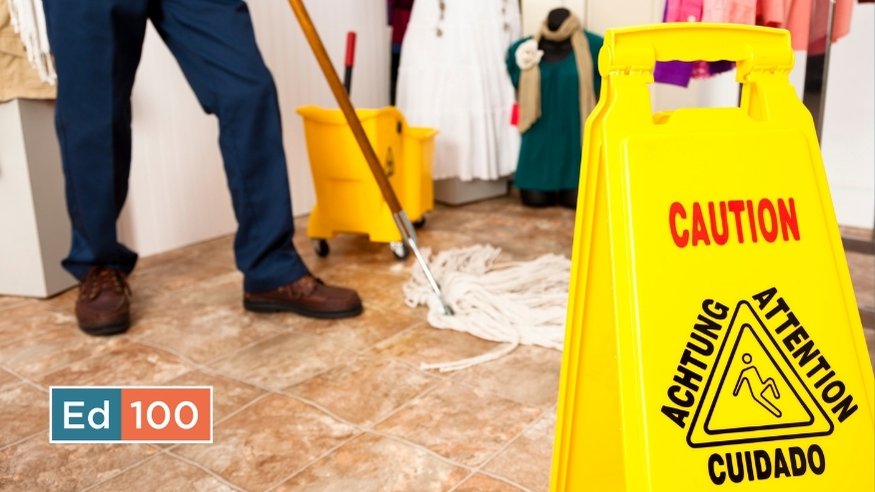Is your school in good shape?

Back-to-school ready
California expects public schools to be safe and clean. Districts tend to use the summer break to freshen up school facilities so they are in good shape when school begins.
In This Post
What was the Williams case?
What did the Williams settlement change?
How are County Offices of Education involved?
Which schools are subject to Williams rules?
How shabby are schools allowed to be?
Why is back-to-school time important?
What's the complaint process?
Click the questions above to find the answers.
This expectation has the force of law, thanks to a state court settlement generally known as the Williams case. In this post, Joseph Knapp explains how this process works, and what parents and educators should know about it, especially in the first month of the school year.
What was the Williams case?
When Eli Williams was in 7th grade in 2000, his school in San Francisco was in bad shape. Tiles were falling from the gym ceiling, the only bathroom available rarely had enough toilet paper and soap, there weren’t enough textbooks for every student in many of the classes, many teachers lacked a credential and were unqualified, and rats plagued the school. One dead rat lay decomposing in the corner of the gym for most of the school year.

Joseph Knapp
Eli’s 7th grade homeroom teacher introduced him and his parents to lawyers with the ACLU. With the encouragement of his father, Eli became the lead plaintiff in a class action lawsuit against the state of California. Ultimately, 100 students from 46 schools across Northern and Southern California became plaintiffs in the case, working with the ACLU and a team of other civil rights lawyers.
Gray Davis, the governor at the time, decided to fight the suit with lawyers and experts who argued that it was the districts’ decision what to spend money on. The case dragged on for almost four years, but when voters recalled Davis, Governor Arnold Schwarzenegger sided with the students. He directed the state to settle the case in 2004.
What did the Williams settlement change?
The Williams settlement led to a lasting set of expectations about how shabby schools are allowed to be. Over time, the settlement has led to a process meant to ensure that all California students have sufficient school facilities and instructional materials. Following the initial settlement, a set of laws established requirements for school districts in three areas: teacher credentialing, instructional materials, and facilities.
The laws gave some teeth to teacher credentialing requirements and set time limits for out-of-state teachers to get an in-state credential.
How shabby are schools allowed to be?
The facilities portions of the laws set a floor on what any reasonable person would deem safe and sufficient for a child. Echoing details from the lawsuit, the laws are specific, even about things that seem obvious. For example, bathrooms should be maintained in working order and fully stocked. Toilets, sinks, and stall doors should all work, and bathrooms are required to have adequate paper, soap, and menstrual supplies. Bathrooms also need to have signs that inform students where to find free menstrual supplies if the stock in the bathroom runs out.
Instructional materials requirements state that all students — including English Learners — have access to board-approved materials both at school and at home. Photocopies of the main class text or shared copies of books are not sufficient. If the materials are digital, the school is required to ensure that all students can access them at home. This means providing laptops and hot spots when required. It’s not sufficient to tell students to go to the library for wifi access.
The role of County Offices of Education
The Williams laws gave some specific duties to County Offices of Education in the role of inspectors. If you see people with clipboards in your school early in the school year interviewing students and teachers and taking notes about the drinking fountains, it could be part of the Williams process.
Which schools are subject to the Williams settlement?
All public schools in California — including charter schools — are subject to the requirements established by the Williams Settlement even if they are not visited by the county office. Not all schools are visited every year.
Every three years, the California Department of Education develops a list of schools that should be visited. Schools are added to the list if they have been identified for additional support under the Every Student Succeeds Act (ATSI or CSI) or if too many teachers are teaching outside of their credential. Schools stay on the list for three years even if they no longer meet the criteria for which they were added to it. The 2025-26 academic year is the beginning of a new three year cycle. You can download the spreadsheet with the schools to be visited here.
Why is the beginning of the school year important?
Most County Offices of Education are required to conduct all visits within the first eight weeks of the school year, which in most places means September or October. There are exceptions for large counties with over 200 schools to visit, but most school visits — both facilities visits and instructional materials visits — take place at the start of the school year. This can be a ton of work for county offices where staff are pulled from their usual tasks to complete all of the visits within the time requirement.
It can be a stressful experience for principals and school staff, too. Even when the school has a good relationship with the county office, few school staff are eager to have folks walking through their campus looking for leaks or missing textbooks. Schools usually know when they will be visited, but 25% of the visits are required to be unannounced.
If the county finds insufficiencies, they are reported to their local school board and recorded in the school’s School Accountability Report Card (SARC). Serious insufficiencies require action, which can have proportional consequences.
What's the complaint process?
How to complain effectively
Visits from the county office only happen occasionally, so the Williams Settlement established a robust formal Uniform Complaint Process to establish a clear way for issues to be noticed and dealt with. Complaints can come from anyone: parents, teachers, and of course students. Williams complaints are not about school lunch options or a new math curriculum. They specifically deal with issues with the facilities, the instructional materials, or teacher credentialing.
If you think that a school needs serious attention, but it isn’t on the list to be visited anytime soon, the complaint procedure is especially important. This resource from Public Advocates has more information about how to file a Williams Complaint, including a useful sample form. Your school is required to post the complaint process in every classroom (unless it’s a charter school). Districts are required to respond to complaints within 45 days.
Are complaints common?
Some districts receive more than their fair share of complaints, but few complaints does not necessarily mean that there are few insufficiencies. The Williams Settlement, the laws, and the complaint process are a little known part of the California Education system and even some experienced teachers don’t know about the complaint process available to them.
Now that you know how the process works, share this post with others. Talk about the conditions in your school, know your rights, and remember that because of students like Eli Williams more students in California have working bathrooms, enough textbooks, and fewer rat problems.
Tags on this post
All Tags
A-G requirements Absences Accountability Accreditation Achievement gap Administrators After school Algebra API Arts Assessment At-risk students Attendance Beacon links Bilingual education Bonds Brain Brown Act Budgets Bullying Burbank Business Career Carol Dweck Categorical funds Catholic schools Certification CHAMP Change Character Education Chart Charter schools Civics Class size CMOs Collective bargaining College Common core Community schools Contest Continuous Improvement Cost of education Counselors Creativity Crossword CSBA CTA Dashboard Data Dialogue District boundaries Districts Diversity Drawing DREAM Act Dyslexia EACH Early childhood Economic growth EdPrezi EdSource EdTech Education foundations Effort Election English learners Equity ESSA Ethnic studies Ethnic studies Evaluation rubric Expanded Learning Facilities Fake News Federal Federal policy Funding Gifted Graduation rates Grit Health Help Wanted History Home schools Homeless students Homework Hours of opportunity Humanities Independence Day Indignation Infrastructure Initiatives International Jargon Khan Academy Kindergarten LCAP LCFF Leaderboard Leadership Learning Litigation Lobbyists Local control Local funding Local governance Lottery Magnet schools Map Math Media Mental Health Mindfulness Mindset Myth Myths NAEP National comparisons NCLB Nutrition Pandemic Parcel taxes Parent Engagement Parent Leader Guide Parents peanut butter Pedagogy Pensions personalized Philanthropy PISA Planning Policy Politics population Poverty Preschool Prezi Private schools Prize Project-based learning Prop 13 Prop 98 Property taxes PTA Purpose of education puzzle Quality Race Rating Schools Reading Recruiting teachers Reform Religious education Religious schools Research Retaining teachers Rigor School board School choice School Climate School Closures Science Serrano vs Priest Sex Ed Site Map Sleep Social-emotional learning Song Special ed Spending SPSA Standards Strike STRS Student motivation Student voice Success Suicide Summer Superintendent Suspensions Talent Teacher pay Teacher shortage Teachers Technology Technology in education Template Test scores Tests Time in school Time on task Trump Undocumented Unions Universal education Vaccination Values Vaping Video Volunteering Volunteers Vote Vouchers Winners Year in ReviewSharing is caring!
Password Reset
Search all lesson and blog content here.
Login with Email
We will send your Login Link to your email
address. Click on the link and you will be
logged into Ed100. No more passwords to
remember!














Questions & Comments
To comment or reply, please sign in .